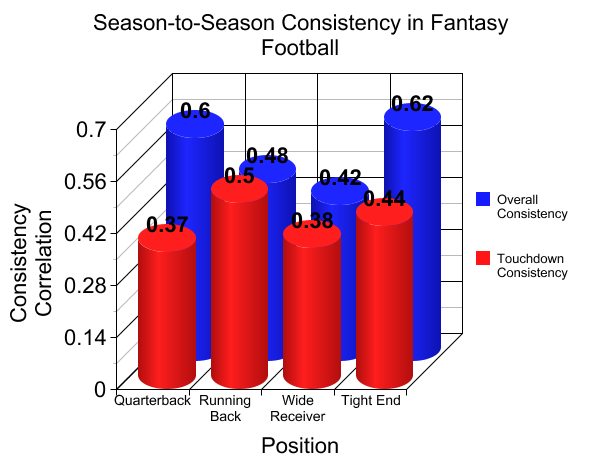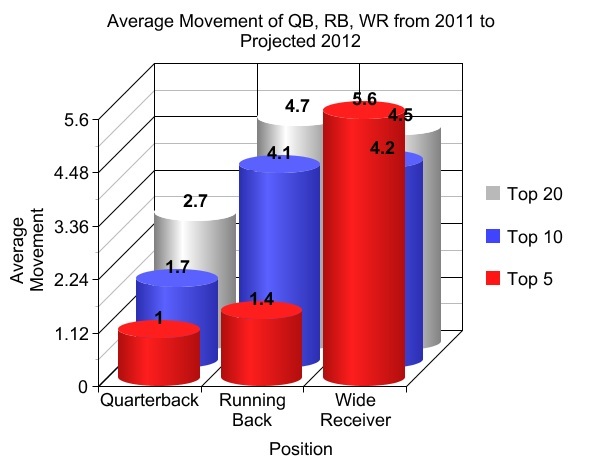If you knew without any doubt one kicker would (hypothetically) score 1,000 points this season, you'd do everything in your power to secure him, right? Even if you were limited to drafting just a single kicker, you might do so in the first round and hope he's the lucky one to outscore all other kickers by about 800 points. If you get it right, the fantasy crown is yours. In the same league, one shrewd owner waits until the last round to draft his kicker. Even with 1,000 fantasy points on the line, he stocks up on skill positions as per usual. Does he know something the rest of his league mates don't?
The fact is that the majority of fantasy owners either ignore or don't fully comprehend position volatility, and it can have dire consequences on their draft strategies. If a particular position had zero predictability - meaning it was impossible to project accurately - we should completely ignore it.
In reality, the kicker position has zero consistency from year to year. As a whole, the position is impossible to predict - pick a starting kicker on any team you'd like, and he'll be just about as likely to lead the league in fantasy points as any other kicker. In other words, the kicker position has amazingly high volatility.
Smart fantasy owners thrive on making accurate predictions. After all, that's really what the draft is about - making predictions that are more accurate than the general consensus in an
If you knew without any doubt one kicker would (hypothetically) score 1,000 points this season, you'd do everything in your power to secure him, right? Even if you were limited to drafting just a single kicker, you might do so in the first round and hope he's the lucky one to outscore all other kickers by about 800 points. If you get it right, the fantasy crown is yours. In the same league, one shrewd owner waits until the last round to draft his kicker. Even with 1,000 fantasy points on the line, he stocks up on skill positions as per usual. Does he know something the rest of his league mates don't?
The fact is that the majority of fantasy owners either ignore or don't fully comprehend position volatility, and it can have dire consequences on their draft strategies. If a particular position had zero predictability - meaning it was impossible to project accurately - we should completely ignore it.
In reality, the kicker position has zero consistency from year to year. As a whole, the position is impossible to predict - pick a starting kicker on any team you'd like, and he'll be just about as likely to lead the league in fantasy points as any other kicker. In other words, the kicker position has amazingly high volatility.
Smart fantasy owners thrive on making accurate predictions. After all, that's really what the draft is about - making predictions that are more accurate than the general consensus in an effort to acquire value with each pick. Without consistency, however, predictions are useless.
That's why understanding the consistency of each position as a whole is vital to garnering maximum value on draft day. All other things being equal, you want the players whose 2012 play is most likely to match up with your projections. The greater the positional and individual consistency, the more likely that is to happen.
So when you're deciding between Calvin Johnson and Aaron Rodgers with the fifth overall pick this season, keep some of this information in mind. One of those players, in all likelihood, is supremely superior to the other in your league; do you know which one is the "right" choice?
The Big Picture
There's no doubt each of your fantasy draft picks should be considered on a case-by-case basis, but position-wide trends should certainly influence your decisions. Specifically, understanding the consistency of each position as a whole can help you create an accurate draft board.
In writing my book Fantasy Football for Smart People, I calculated the year-to-year consistency of each position to help owners acquire a solid understanding of just how easy it is to project points for each player.
These consistency correlations can also be thought of as confidence ratings, that is, how confident can you be that your projection for a player is spot on? If the strength of correlation for quarterback fantasy points were theoretically 1.00, we'd be able to accurately project each player's points each and every time. If the correlation were 0.0, as is the case with kickers, projections would be useless - picking a player with a season-to-season consistency correlation of zero is synonymous to playing roulette. There's no way to beat the house.
Luckily for us, accurate projections are attainable. The degree to which we can predict the play of specific players, however, varies based on a multitude of factors, their position being perhaps the most important of those. So without further ado, here are my findings:

Above, you can see the consistency of each position from one season to the next. This data was taken over the past decade.
For all intents and purposes, you can think of each correlation as the percentage of a player's stats that carry over from one year to the next. For example, you can see the overall consistency correlation for quarterback points is 0.60. This means, on average, 60 percent of a quarterback's points from the previous season are repeated in the current year, while 40 percent regress toward a league mean. If Player X scored 400 points but the league mean for quarterbacks was 250, a solid baseline projection for that player would be 400(0.6) + 250 (0.4), or 340 points.
One benefit of translating such correlations into projections is a natural implementation of regression toward the mean. If a player scored 400 fantasy points, for example, chances are he overachieved and is thus likely to post fewer fantasy points the following season. A formula that uses consistency correlations automatically factors regression toward the mean into account, and is thus inherently more accurate than a simple mirroring of prior stats.
Another benefit of utilizing consistency is it provides a measurement of confidence. We can project stats all day, but it means nothing if we can't assign a likelihood of occurrence. Knowing that 60 percent of a quarterback's stats or 38 percent of a wide receiver's touchdowns will repeat themselves from one season to the next is useful information that can and should influence your rankings. Going back to our 1,000-point kicker example, it doesn't matter how many points you project a player to score (or even the gap between him and the next player at his position) if you can't be confident in your prediction.
Breaking Down the Positions
Looking at the overall consistency correlations for each of the four skill positions, there are some interesting numbers. You might be surprised to see that tight end is actually the most consistent (and thus predictable) position in fantasy football, followed closely by quarterback, then running back and finally wide receiver. Actually, only 42 percent of a typical wide receiver's performance carries over from year to year.
Interestingly, the distribution of projections for 2012 matches up with the above graph quite well. Using a simple regression of players' stats, I calculated the difference in each player's 2011 rank and projected 2012 rank. The graph below displays this movement.

It's worth noting I didn't use any subjective analysis in creating the projections for this analysis; I simply used a regression of efficiency stats (such as yards-per-reception, yards-per-carry, and so on), then calculated the projected points.
You can see that the wide receiver position is dramatically more volatile than running back and quarterback, particularly early in the draft. Among the top five quarterbacks from last year, the projected change in 2012 rank is just one spot per player. This means Aaron Rodgers, Drew Brees and the other top-tier quarterbacks are highly unlikely to fall out of the top five, barring injury.
Interestingly, the top-tier running backs are nearly just as consistent. Despite an overall consistency correlation of just 0.48 (compared to 0.60 for quarterbacks), the top five running backs are projected to move an average of only 1.4 spots in the rankings by the end of 2012. Acquiring one of these top-tier players is wholly important if you own an early pick this season.
On the other hand, the top five receivers from 2011 are projected to move an average of 5.6 spots in 2012. This means a guy like Calvin Johnson is probably more likely to end up seventh in wide receiver points than first. If that seems impossible, go ahead and look at the final wide receiver rankings from the past few seasons - rarely will you see the same players again and again. Meanwhile, you can draft Aaron Rodgers or LeSean McCoy and take their 2012 fantasy points straight to the bank.
Outside of the top tier, you can see the volatility at the running back position skyrockets. Meanwhile, the lack of volatility of middle-tier receivers is really amazing; the No. 20 receiver from 2011 is projected to move less than the No. 5 receiver, for example.
Similarly, top-10 wide receivers are nearly as consistent as top-10 running backs, meaning the third, fourth, and fifth rounds are a great time to target receivers. If you were able to nab a top-tier running back in the first round and the best non-receiver in the second, you'll be in a great position to stock up on players like A.J. Green, Jordy Nelson and Dez Bryant in the subsequent rounds.
Practical Application
The purpose of implementing consistency into your rankings isn't to scare you away from taking any receiver in the first few rounds of the draft, but rather to provide an understanding of which positions tend to remain stable from year to year. If you're deciding between a tight end and a wide receiver in the third round, and everything else seems equal, you might want to go with the player whose 2011 performance is most likely to repeat.
I think the consistency correlations are most useful at the top of the draft. In the first round or two, your goal should be to minimize downside. In that area, everyone's upside is high. Actually, the top-ranked players are really the "outliers" from the previous season - they overachieved and their production is probably going to decline in the subsequent season. Thus, the best you can hope for is really a repeat performance, which would mean you really just got what you paid for.
If you have the first overall pick, for example, chances are your selection won't live up to his draft spot. The cost is so great that your pick can only provide a marginal return on investment. This means you should maximize the floor of your early picks; that is, select safe players whose play isn't volatile. Safe picks in the early rounds are boring, but they win fantasy championships. The middle and late rounds are the times to take your risks.
Going back to the Rodgers/Johnson dilemma I posed earlier, the choice seems a bit easier. Megatron is a heck of a player, but his performance isn't nearly as likely to repeat this season as that of Rodgers. If you add consistency into your rankings and follow your board on draft day, you'll be well on your way to outsmarting the competition in 2012.
Jonathan Bales is the author of Fantasy Football for Smart People: How to Dominate Your Draft. He also runs the "Running the Numbers" blog at DallasCowboys.com and writes for the New York Times.
























